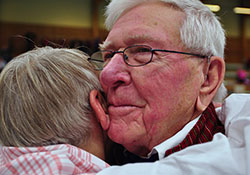Health and social care systems

Malin Bring
As the population of the Region ages, present models of health service delivery will become increasingly challenged. A package of well-coordinated and high-quality services will be needed, delivered by staff who are well prepared to address the specific needs and risk factors affecting older people. Informal care provided by family and friends will also need to be supported and improved to allow people with functional limitations to stay at home as long as possible.
Meeting the Region's future health care needs will thus require a greater focus on, for example:
- health workforce planning and training
- vaccination and infectious disease prevention
- long-term care, including home care.
Health workforce
The rise in chronic health problems in ageing populations helps to raise the demand for health workers. In addition, the health workforce is ageing in many countries in the Region. For example, in Denmark, France, Iceland, Norway and Sweden, the average age of nurses employed today is 41–45 years.
National and subnational capacity for training in geriatrics and gerontology is often insufficient. This includes both gaps in the knowledge of general practitioners and other care providers and insufficient specialist training and specialists in geriatrics. WHO urges that health providers be adequately trained on ageing issues.
Vaccination and infectious disease prevention
Vaccine coverage rates of older people and the health and social care workers who work with them are often inadequate in the European Region, even though vaccination can significantly reduce disease, hospital admissions and mortality among older people.
Though usually mild and uncomplicated in the general population, influenza infection may cause severe disease among elderly people and those with underlying medical conditions, such as chronic heart or lung diseases. In elderly people, influenza vaccination reduces severe illness and complications by up to 60% and influenza-related deaths by up to 80%.
In addition, vaccination against influenza and pneumococcal infection is increasingly seen as effective secondary prevention for older people suffering from chronic diseases, especially coronary heart disease or arthrosclerosis.
Long-term care
WHO defines long-term care as:
“the system of activities undertaken by informal caregivers (family, friends and/or neighbours) and/or professionals (health and social services) to ensure that a person who is not fully capable of self-care can maintain the highest possible quality of life, according to his or her individual preferences, with the greatest possible degree of independence, autonomy, participation, personal fulfilment and human dignity”.
This type of care is provided by both informal and formal support systems. The latter include a broad range of community services (public health, primary care, home-care and rehabilitation services and palliative care), as well as institutional care in nursing homes and hospices. Treatments that halt or reverse the course of disease and disability are also included in this category.
Older people’s use of long-term care varies widely across the Region. The share of people aged 65 and older receiving services in institutions ranges from less than 1% (in Poland and the Russian Federation) to 9% (in Iceland). The share of those receiving publicly funded services at home ranges from very small in many countries in eastern Europe to 25% in Denmark. In almost all countries, most (often close to 80%) of those receiving long-term care are aged 80 and above.
Further, access to and the quality of nursing homes differ widely in Europe. Cost-sharing alone can constitute a financial barrier. Long-term care institutions often require a prohibitively high user’s fee (on top of public funding), in some cases exceeding the net wage received by a so-called average production worker.
Home care
Most people prefer to live, and if possible spend their final days, at home, but public policy has been slow to support a shift from institutions and hospitals to home-based settings. In all European countries, informal care accounts for the majority of care-hours, even in countries with the largest publicly supported elderly care sectors. Nevertheless, most public funding for long-term care continues to go to institutional care: over 70% in Belgium, Iceland and Switzerland. Such funding accounts for 0.3–3.9% of gross domestic product.
With the group aged ≥80 growing faster than any other and the average age of caregivers for the elderly rising, a better balance is needed between informal care and public support. Putting an appropriate and coordinated mix of services in place (including health and social services; technical aids; support to informal care) is key to making health and long-term care systems sustainable in the future.



